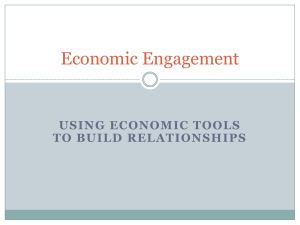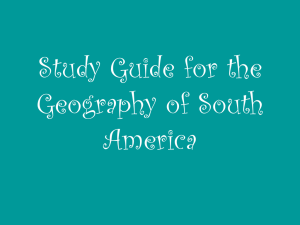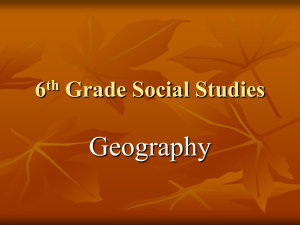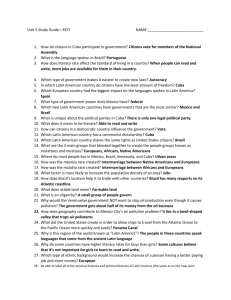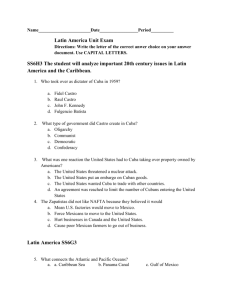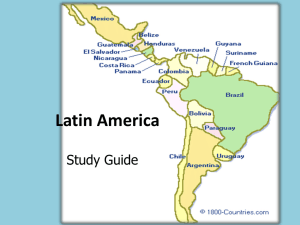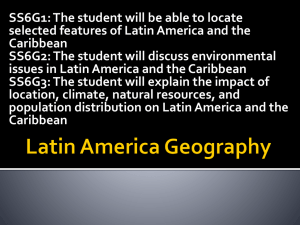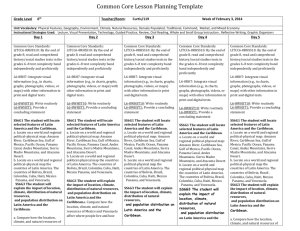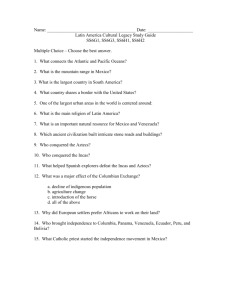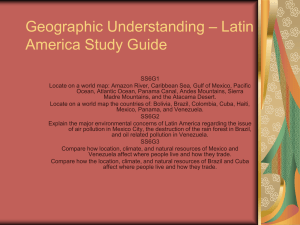Latin America - Polk School District
advertisement
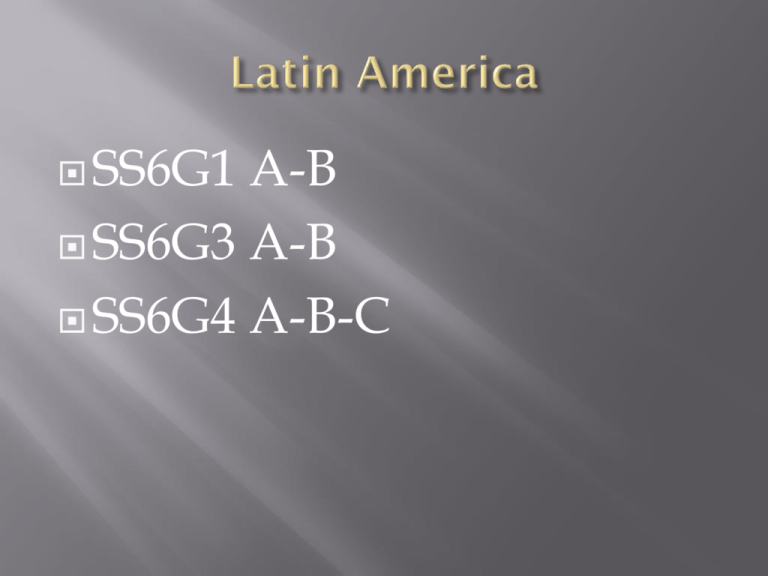
SS6G1 A-B SS6G3 A-B SS6G4 A-B-C SS6G1 The student will locate selected features of Latin America and the Caribbean. a. Locate on a world and regional political-physical map: Amazon River, Caribbean Sea, Gulf of Mexico, Pacific Ocean, Panama Canal, Andes Mountains, Sierra Madre Mountains, and Atacama Desert. b. Locate on a world and regional political-physical map the countries of Bolivia, Brazil, Colombia, Cuba, Haiti, Mexico, Panama, and Venezuela. SIERRA MADRES MTNS. Atacama Desert – Located in Chile La Mano del Desierto (Hand of the Desert) Andes Mountains You Must Know: Mexico Haiti Brazil Bolivia Colombia Venezuela Cuba Panama SS6G3 The student will explain the impact of location, climate, distribution of natural resources, and population distribution on Latin America and the Caribbean. a. Compare how the location, climate, and natural resources of Mexico and Venezuela affect where people live and how they trade. b. Compare how the location, climate, and natural resources of Brazil and Cuba affect where people live and how they trade. Teacher Talk: Compare how the location, climate, and natural resources of ____________affect where people live and how they trade. Translation: “How does where a place is, what it feels like and what it has, compare to another place?” Now all you have to do is make a simple comparison: Country A Country B Where is it? What's it feel like? What's it got? Are there advantages for one country (or countries) over another (or others)? MEXICO VENEZUELA Where is it? Both nations have large coastlines and populations that rely on the sea for their living. Mexico is part of North America, but Venezuela is part of South America. Climate? Both Mexico and Venezuela have warm to semi-tropical climates in some parts of their countries. Both are influenced by weather patterns brought into their countries by the oceans. Natural Resources? OIL (petroleum) is now the chief natural resource for both countries. Venezuela has done a better job of exploiting that natural resource, but Mexico is working hard to catch up. Summary: Mexico and Venezuela are similar in climate and natural resources. CUBA BRAZIL Where is it? Cuba is located about 90 miles from the southern tip of Florida. It is an island nation in The Caribbean Sea. Brazil is the largest country in South America with an extensive coastline touching the Atlantic Ocean where most of it’s people live. Many larger cities are surrounded by Favelas or large slum areas. Climate? Cuba’s climate is generally warm, mild and semi-tropical. It is often affected by ocean storms and hurricanes. Brazil’s climate is tropical and humid in many locations and warm and mild along the coastline. Natural Resources? Cuba has limited natural resources. They have nickel, copper and arable land. Brazil has extensive timber resources, as well as, gold and petroleum deposits. SS6G4 The student will describe the cultural characteristics of people who live in Latin America and the Caribbean. a. Describe the results of blending of ethnic groups in Latin America and the Caribbean. b. Explain why Latin America is a region based on the languages of Portuguese and Spanish. c. Evaluate how the literacy rate affects the standard of living. People of European, African and Native American heritage make up the 3 main ethnic groups in Latin America and The Caribbean. When European explorers began to land and colonize, they inter-married with many of the local Native American people. Those descendants make up a large percentage of the population in some countries. (and are sometimes referred to as Mestizos) The importation of African slaves into The Caribbean and Central and South America introduced another ethnic population into the region. Descendants of European and African mixed race are sometimes referred to as Mulattoes. Most of the languages spoken in Latin America today are based on Spanish or Portugese because those two European powers did most of the exploring and conquering in Latin America. (since both Spanish and Portugese are based on the old Latin language of the Romans…..Latin America) That is also why the Roman Catholic branch of Christianity is the predominant religion there. Both Spain and Portugal were (and are) Catholic nations. A person who is able to read and write is considered literate. Literacy is a major factor in whether a person is able to get a job and be successful in the workplace. The ability to read and write ensures that knowledge can be passed down from one generation to the next. The lower the literacy rate the more than likely the country is very poor. In some cultures it is believed to be more important for boys to have an education than girls. In some countries, the government does not, or cannot, provide free public education. Many times the communities cannot afford to pay for teachers and schools. Workers are stuck in the lowest-paying jobs. People can’t get an education, so they can only get low-paying jobs. Because they can only get low-paying jobs they cannot get enough money to pay for their children’s education.
